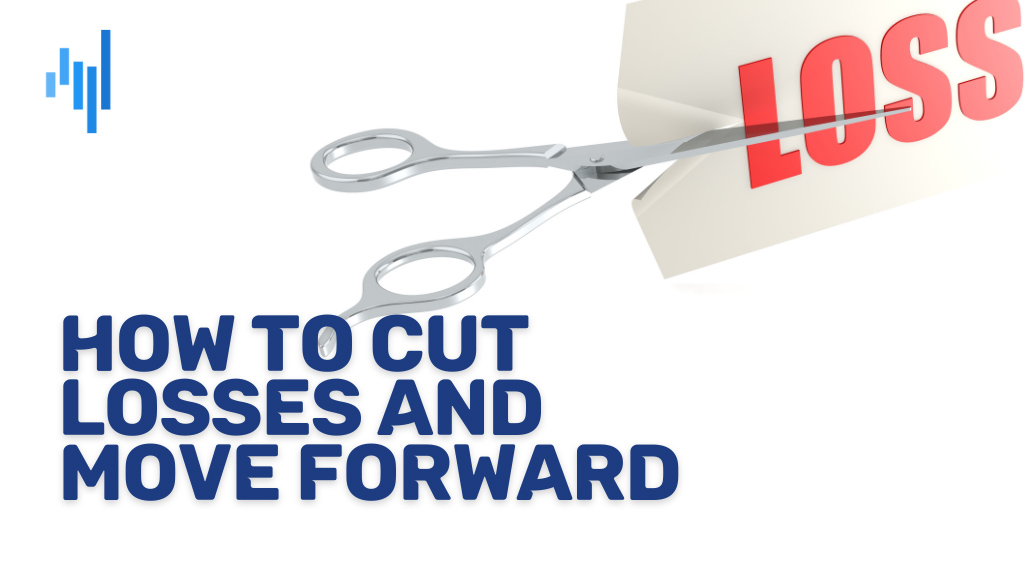The Dangers of Holding Onto Losing Positions: Why Letting Go Can Save Your Portfolio

Holding onto a losing position is a common mistake that can severely impact your portfolio. Many traders, influenced by loss aversion - a tendency to avoid losses at any cost - hope for a market turnaround instead of cutting their losses. This mindset not only increases losses but also limits future opportunities. Understanding the risks of holding losing trades is essential for maintaining a disciplined and successful trading approach.
Understanding Why Traders Hold Losing Positions
Why do many traders hold onto losing positions, even when the risks are clear? The answer lies in human psychology. One key factor is loss aversion, where traders hold onto losing trades to avoid the emotional pain of realizing a loss. The hope that a trade might turn profitable can feel more bearable than accepting the loss, even though this "hope" often comes at a high cost.
Overconfidence also plays a role. Traders who strongly believe in their analysis or have a high conviction in a trade may refuse to cut losses as they wait for the market to turn in their favor. This can make it difficult to admit mistakes or adjust strategies, leading to denial and ignoring warning signs.
The sunk cost fallacy is another bias at play. Traders may feel compelled to continue holding a losing position because of the money or time already invested. Selling at a loss feels like wasting resources, even though holding on only increases the potential for further losses.
Together, these biases - loss aversion, overconfidence, and the sunk cost fallacy - trap traders in unprofitable positions. Recognizing these psychological factors is key to improving trading discipline and avoiding the financial pitfalls of holding onto losing trades for too long.
Also read: CFD Trading Psychology: Mastering Emotions for Better Results

The Real Cost of Holding Losing Positions
The financial impact of holding onto losing positions is significant and often underestimated. When a trader holds a losing position, they aren’t just risking the initial investment - they’re also tying up capital that could be used for potentially profitable trades. This is known as the opportunity cost of holding a losing trade. By leaving funds tied up in an underperforming position, traders miss out on other opportunities that could generate returns, effectively reducing the growth potential of their portfolio.
Consider a hypothetical example. Imagine a trader who invested $10,000 in a stock, but the stock has since dropped 20% in value, reducing the position to $8,000. The trader, hoping for a turnaround, decides to hold onto the position. Meanwhile, other stocks in the market are performing well, with an average return of 10% over the same period. By keeping their funds locked in the losing trade, the trader not only risks further losses but also forgoes the potential gains they could have earned by reallocating the $8,000 into a better-performing investment.
Another major financial consequence is the increase in losses over time. Markets can sometimes be volatile, with assets dropping even lower before they stabilize or recover. Holding onto a losing position in the hope of a reversal often leads to further depreciation in value. If the trader had initially sold at a 20% loss, they would have retained $8,000. However, if they continue holding and the stock declines another 10%, they’re left with only $7,200 - a far worse outcome. This compounding effect of losses makes it crucial for traders to set realistic Stop Loss orders and stick to them.
Finally, holding onto losing trades reduces the capital available for other investments. In trading, liquidity - having accessible funds ready for new opportunities - is essential. When funds are tied up in losing positions, traders lose the flexibility to adapt to market changes and capitalize on new, potentially profitable trades. This lack of available capital can restrict a trader’s options, reducing the overall performance of their portfolio.
In summary, holding onto losing positions has clear financial drawbacks: it increases the risk of deeper losses, incurs opportunity costs, and limits liquidity for future trades. Recognizing these costs and understanding the psychology that drives the behavior can help traders make more disciplined decisions, ultimately protecting their capital and improving their chances for success.
Recognize When It’s Time to Let Go
One of the most challenging aspects of trading is knowing when to exit a position, especially if it’s showing a loss. Many traders find themselves holding onto losing trades, hoping that the market will eventually turn in their favor. However, there are clear warning signs that indicate it’s time to let go and move on. Recognizing these signs can prevent you from incurring further losses and help you maintain a healthy, disciplined approach to trading.
A common warning sign is an emotional attachment to a trade. If you find yourself feeling overly invested in a specific position or convincing yourself that the market "owes" you a reversal, it’s a red flag. Emotional attachment clouds judgment, making it difficult to objectively assess the trade’s performance. In this state, traders often ignore the logical decision to cut losses, allowing emotions to override sound trading principles.
Another sign is ignoring Stop Loss signals. Stop Loss orders are set to automatically close a position if it reaches a certain level of loss, protecting you from deeper declines. If you frequently cancel or adjust your Stop Loss levels to “give the trade more room,” you may be holding onto the position for the wrong reasons. Ignoring these pre-set limits can lead to significantly larger losses, as it indicates a reluctance to accept the trade’s failure.
Rationalizing losses is another indication that you’re holding onto a losing position too long. If you’re justifying a trade’s poor performance with excuses like “the market is just temporarily down” or “this stock always bounces back,” you may be falling into the trap of wishful thinking. Rationalization often stems from a desire to avoid admitting a mistake, but in trading, acknowledging when a position isn’t working out is a critical part of success.
Recognizing these signs early can save you from larger losses and help you stay disciplined. By keeping an eye out for emotional attachment, ignoring Stop Loss signals, and rationalizing losses, you can avoid the pitfalls of holding onto losing trades too long and stay focused on making sound trading decisions.
Also read: The Risks and Consequences of Trading Forex Without a Strategy: Why a Plan is Essential for Success

How to Cut Losses and Move Forward
Letting go of losing trades is easier said than done, but with the right strategies, you can develop the discipline needed to protect your portfolio and minimize losses. Here are some actionable techniques that can help you cut losses and move forward more effectively.
One of the most effective strategies is to set strict Stop Loss orders and stick to them. Stop Loss orders allow you to define the maximum amount you’re willing to lose on a trade, and they automatically close the position if that limit is reached. By setting these limits in advance, you can remove emotion from the decision-making process and protect your capital from further loss. Make sure to resist the temptation to adjust your Stop Loss levels; doing so undermines the purpose of this risk management tool.
Following a trading plan is another essential strategy. A well-defined trading plan outlines your entry and exit points, risk tolerance, and profit targets. When you have a plan in place, it’s easier to stay disciplined and avoid impulsive decisions. If a trade isn’t performing as expected and hits your Stop Loss, your trading plan should guide you to exit the position rather than hold on and hope for a turnaround.
Risk management techniques, such as position sizing and diversification, can also help you cut losses. By limiting the size of each position relative to your overall portfolio, you reduce the financial impact of any single trade. Diversification - investing in different assets - helps balance risk and reduces the likelihood that one losing trade will significantly harm your portfolio. These techniques encourage a disciplined approach that prioritizes the health of your portfolio over emotional attachment to individual trades.
Finally, reviewing trades regularly is a valuable practice for maintaining discipline. Setting aside time to evaluate both your successful and unsuccessful trades can help you identify patterns and refine your strategy. By objectively reviewing your trades, you’ll be better prepared to recognize when a position isn’t working and act accordingly. This habit not only builds discipline but also strengthens your overall trading strategy over time.
With these strategies - using Stop Losses, following a trading plan, practicing risk management, and reviewing trades - you can develop the discipline needed to let go of losing trades, reduce emotional decision-making, and focus on building a healthier portfolio.
Why Letting Go Can Strengthen Your Portfolio
While cutting losses may feel difficult in the moment, the long-term benefits of letting go of losing trades are undeniable. By learning to exit unprofitable positions early, traders can protect their portfolios, preserve capital, and ultimately improve their trading performance.
One of the main benefits of cutting losses early is preserving capital. When you quickly exit a losing trade, you prevent further erosion of your investment, leaving more funds available for future opportunities. This preservation of capital is crucial in trading, as it allows you to stay in the game and continue exploring new, potentially profitable positions. Holding onto losing trades, on the other hand, depletes your resources and limits your ability to recover.
Maintaining emotional stability is another significant advantage. Constantly watching a losing trade can lead to stress, frustration, and impulsive decisions, which negatively impact your trading mindset. By cutting losses early, you can avoid the emotional rollercoaster of hoping for a turnaround and focus instead on trades that align with your strategy. This emotional stability is essential for making rational, data-driven decisions in your trading practice.
Finally, cutting losses quickly allows you to focus on better opportunities. In trading, time and capital are valuable resources, and tying them up in losing positions limits your flexibility. When you exit a bad trade promptly, you free up capital and mental energy to pursue other trades with higher potential. This shift in focus increases the likelihood of achieving your trading goals, as it aligns your actions with a proactive, opportunity-oriented mindset.
In summary, cutting losses early offers several benefits that strengthen your portfolio and your trading discipline. By preserving capital, maintaining emotional stability, and freeing up resources for new opportunities, you set yourself up for more consistent success and protect yourself from the pitfalls of holding onto losing trades.
Also read: Trader's Checklist for Successful Trading
Conclusion
In the world of trading, discipline is paramount. Holding onto losing positions can be a costly habit that drains your portfolio and undermines your long-term success. By recognizing the warning signs, implementing strategies to cut losses, and understanding the benefits of letting go, you can build a disciplined approach to trading that prioritizes preservation and growth.
As you evaluate your trading strategies, remember that letting go of losing trades is not a failure but a strategic choice that protects your capital and keeps you focused on the bigger picture. Embrace the discipline to cut losses when needed, and you’ll be well on your way to a healthier, more resilient portfolio.
Ready to improve your trading discipline? Learn more about managing risks and making informed trading decisions with AdroFx. Start practicing disciplined trading today!
About AdroFx
Established in 2018, AdroFx is known for its high technology and its ability to deliver high-quality brokerage services in more than 200 countries around the world. AdroFx makes every effort to keep its customers satisfied and to meet all the trading needs of any trader. With the five types of trading accounts, we have all it takes to fit any traders` needs and styles. The company provides access to 115+ trading instruments, including currencies, metals, stocks, and cryptocurrencies, which make it possible to make the most out of trading on the financial markets. Considering all the above, AdroFx is the perfect variant for anyone who doesn't settle for less than the best.










